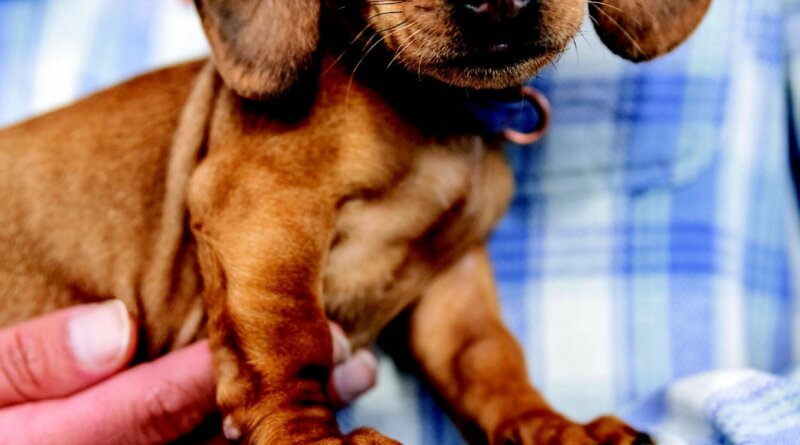First Timers’ (and Second and Third Timers’) Guide to Puppy Care – Dogster
Puppies are so cute and adorable. But unless you have lived with one, you have no idea how much work they can be. That boundless energy combined with little to no self-control and a mouth full of sharp teeth can be a real challenge. Knowing what to expect and how to deal with it can make a huge difference between success and frustration when raising a puppy.
Here are 10 issues you might face when you first get your puppy and ways to handle each.
-
Crying at night
Young puppies can only hold their urine for a few hours without having to relieve themselves. If your pup wakes you up crying in the middle of the night, take him outside on a leash and wait for him to potty. Put him right back in the crate afterward.
A rule of thumb to go by: One hour for every month old the puppy is and then add an additional hour. This means if your puppy is 4 months old, he should be able to hold it for five hours. If he can’t, he may have a UTI, not uncommon in puppies, or another issue. (Get him checked by a veterinarian.) Also, check the bedding in the crate, as he may have had an accident and will need fresh, clean bedding.
-
Using a crate
Crate training provides so many benefits for new puppy parents, according to Petra Burke, co-owner of Kindred Spirits Dog Training in Vista, California. “It helps to potty train them and, if done right and if you stick to your routine, you should have the pup crate trained in three nights.”
“If you go to bed at 10 p.m., take pup out for the last potty break, then into the crate,” Petra says. “You may or may not have to potty them sometime in the middle of the night. Then get up at 6 a.m. and potty again.”

A pup should be able to be in a crate for naps during the day for about 30 minutes to an hour. “A 6-month-old pup should be able to stay in a crate for two to three hours,” Petra says. “As they get older, they can stay in longer.”
Expect your pup to cry at first as she gets used to the crate, as it takes time to adjust. A few toys and comfy bedding makes it more enticing. Never use the crate as punishment nor put your pup in there for too much time. When you are gone during the day, you can eventually move your pup from the crate to an enclosed area of the home. Put him right back in the crate afterward. (For tips on crate training, see our article “Simple Tips for Crate Training a Dog”).
-
Dreaded diarrhea
Changing food, new treats, new people and environment, plus eating everything in sight that they shouldn’t — it all spells poop problems. However, if your puppy has diarrhea for more than one day or the diarrhea is accompanied by vomiting or lethargy, call your veterinarian immediately for direction, then take him in for an exam. While an occasional bout of diarrhea is not a big deal, frequent diarrhea can be a symptom of serious illness in puppies. Be prepared: Your veterinarian may ask you to bring in a sample to test.
-
Microchip musts
Get your puppy microchipped in case he ever gets lost. A microchip or a DNA sample is also the only way to prove your dog is legally yours.
It’s a simple procedure: Using a needle, a veterinarian implants the microchip under the skin at the back of your puppy’s neck. If your dog ever gets lost, the chip can be scanned at an animal shelter or veterinarian’s office using a scanner. The scanner reads the microchip number, which corresponds to your name, address and phone number, which resides in the microchip manufacturer’s database.

Dogs adopted from shelters or reputable breeders are typically already microchipped, you just need to go to the company that has the information and update it to your contact information. If your dog is not microchipped, your veterinarian can do it, plus there are a lot of free or low-cost microchipping events put on by animal welfare organizations.
-
Water matters
Puppies need access to fresh water at all times, although you can withhold it a few hours before bedtime. If you are feeding dry food to your puppy, make sure he has the opportunity to drink for at least a few hours after eating dinner.
-
Time for a vet visit
After your pup sees the vet for the first time for a health check, the number of subsequent visits will depend on your pup’s vaccines schedule, according to Heidi Watkins, DVM, with Wagly Veterinary Hospital in Rancho Santa Margarita, California.
“Any health issues or concerns that arise outside the scope of wellness should prompt an immediate check by your veterinarian,” Dr. Watkins says.

-
About those shots
All puppies should receive core vaccines that protect against parvovirus, distemper virus, adenovirus, parainfluenza virus and rabies virus, says Dr. Watkins.
“Non-core vaccines for puppies and adults may vary to some degree based on the region of the country you live in and what outbreaks have been seen in your area,” she says. “This group includes lyme, leptospirosis, canine influenza H3N8 and H3N2 and even rattlesnake vaccines.”
Parvovirus, distemper, adenovirus and parainfluenza vaccines are typically started at 8 weeks of age, and are boostered every three weeks, for a typical total of three doses. By about 10 weeks of age, Bordetella vaccine is given. Rabies is the only vaccine that is mandated by states, where a minimum age is required.
“All puppies should receive core vaccines that protect against parvovirus, distemper virus, adenovirus, parainfluenza virus and rabies virus,” Heidi Watkins, DVM
-
Intros to other pets
You want to teach your pup that these smaller critters are members of the family and should not be harassed. Also, you should never leave puppies unsupervised with small animal housemates.
Start by introducing the small pet in a cage with the puppy on leash, according to Petra.
“Let them look at each other and sniff while you are praising the pup,” she says. “If the puppy starts getting excited, separate them. The puppy should not be allowed to start barking or lunging at the small animal. That works up the puppy and can stress the small animal.”
Petra says to be aware of the natural tendency of your pup’s breed.
“For example, terriers are natural hunters, so introduce small animals slowly,” she says. “Herding breeds have a prey drive, so do not allow chasing. Teaching your pup the ‘leave it’ cue can be extremely helpful.”
Dogs and cats can live in harmony when introduced correctly and with patience, Petra adds. She advises having a place your cat can go to get away from the puppy, such as an area blocked off with a baby gate

-
Time for training
Puppies are like sponges. They soak up everything and learn quickly, according to Petra. “I suggest starting training immediately,” she says. Start by putting a collar on your puppy as soon as you bring her home. Then attach a leash and let her drag it around. Next, teach her to walk with you holding the leash. You should also begin housetraining right away, as well as sleeping in a crate. Teach the puppy his name. You can even teach her to sit right.
Follow all this up by enrolling in a puppy class once your puppy has had at least two sets of vaccinations. This will start the socialization process with other puppies and people, according to Petra.

-
Puppy-proofing
Puppies shouldn’t be trusted with too much freedom, so pick one room of the house for the puppy to stay and proofing to start. Look for any items he might chew on, such as wiring, wooden furniture or books, and block off access with baby gates or wire dog pens. It’s a good idea to get down on your knees to see the room from your puppy’s perspective, and remove any items that he may want to chew on or destroy.




